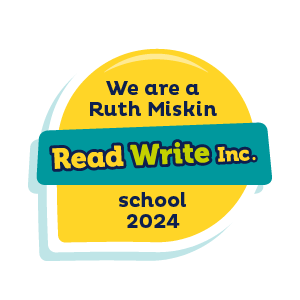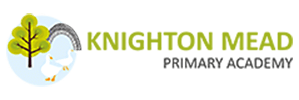At Knighton Mead Primary Academy, we use the Read Write Inc. (RWI) programme to get
children off to a flying start with their reading and writing skills 
This page has been created to offer information and useful resources for parents at home, when helping their child.
When using RWI the children will:
- Learn 44 sounds and the corresponding letter/letter groups using simple picture prompts.
- Learn to read words using Fred Talk.
- Learn to read words by blending the sounds together.
- Read lively stories featuring words they have learnt to sound out.
- Show that they understand the stories by answering ‘Find It’ and ‘Prove it’ discussion questions.
- Learn to read effortlessly so that they can put all their energy into understanding what they read.
When using RWI to write the children will:
- Learn to write the letters/letter groups which represent the 44 sounds (graphemes).
- Learn to write words by saying the sounds in Fred Talk.
- Learn to write simple and then increasingly complex sentences.
- Compose a range of texts using discussion prompts.
- Compose stories based on picture strips.
- Spell effortlessly so that they can put their energy into working out what they want to write.
For an introduction to RWI phonics please watch the video below:
Parent video: What is Read Write Inc Phonics (youtube.com)
Speed Sounds:
RWI phonics involves using ‘pure sounds’ to learn to read and spell. The following video shows examples of all of the speed sounds.
Parent video: How to say the sounds – YouTube
Children are taught to form letters using a selection of rhymes. You can find the rhymes on this sheet:
The speed sounds are taught in 3 different sets and get more complex as they work through them:
A list of the speed sounds can be found here:
It includes rhymes for special friends (one sound shown by more than 1 letter).
Blending:
Using these simple sounds, children will learn to ‘blend’ words together, so c-a-t becomes cat. To help the children do this, we have a lovely green frog called Fred! He can only talk in sounds, so the children put the sounds together to make the word. We call this ‘Fred Talk’. This is also used in early reading, as when children see a new word they can use ‘Fred Talk’ to break down the sounds and then say or read the word.
Similarly, this supports early writing skills as children use ‘Fred Fingers’ to break down a spoken word into its sounds to enable them to write the word. We use the phrase ‘Say the word – pinch the sounds’ to help children remember.
When they are confident with blending and know all of their Set 1 sounds, the children will move onto Set 2 sounds and then Set 3 sounds, which introduce alternative spellings for sounds they know and more special friends. They may begin to use ‘Fred in their head’ to read more quickly and fluently, which helps to build up speed, however this stage is also tricky for children as they need to be able to spot ‘special friends’ easily within new words. Words which can be decoded are called ‘Green Words’ as they can be decoded using phonics knowledge. Unfortunately, there are lots of words in the English language that do not follow these rules … they are called ‘Red Words’ and need to be learned by sight. We use the phrase ‘If it’s red – it’s hard for Fred’ to remind children.
The following video shows examples of blending and Fred talk.
Parent video: Sound blending – YouTube
Red Word Challenge:
‘Red Words’ often cannot be blended and need to be learned by sight. We use the phrase ‘If it’s red – it’s hard for Fred’ to remind the children. We have created a challenge to support children in learning to read and write these words from memory.
These Red words will come in the order of stories the children read in their phonics sessions. Each challenge has a few words at a time to learn. Staff will then check children’s ability to read and write these words at random. When they complete a challenge card, they will receive a certificate in our Friday whole school celebration assembly and have a new challenge card to learn sent home in their Red Word Challenge books.
Here is a list of our Red Word Challenge words:
A few ideas of fun ways to learn the Red Words can be found here:
Red Word Challenge Learning Ideas
Phonics Screening Check:
What is the Phonics Screening Check?
The Phonics Screening Check is a test for children in Year 1. Children take it during June in a one-to-one setting with a teacher. This is usually their class teacher or another teacher who knows the child well.
Whilst children learn phonics to help them with both word reading and spelling, the Phonics Screening Check only tests their skills at word reading. During the Phonics Screening Check, children are asked to read (decode) 40 words. Most of these words are real words but some are alien words. Alien words are included to ensure that children are using their decoding skills and not just relying on their memory of words they’ve read before. Because some children may misread these alien words based on their similarity to words in their existing vocabulary, each alien word is clearly identified with an image of an alien.
The test itself is divided into two sections. Section 1 is the easier part. In this section, children are asked to recognise simple word structures and Grapheme Phoneme Correspondences (GPCs) from the earlier phases of the phonics curriculum. In 2019, real words included in Section 1 were words like ‘shop’, ‘peel’ and ‘yell’.
Section 2 is the trickier part of the test. Here, children need to recognise GPCs from the later stages of the phonics curriculum. They also encounter graphemes that correspond to more than one phoneme (e.g. the grapheme ‘ea’ represents different phonemes in the words bread and bead.)
If a child doesn’t meet the expected standard, we will work with them to ensure they receive the phonics teaching and support they need. The child will then retake the Phonics Screening Check the following year.
Parent video: The Phonics Screening Check – YouTube
Reading for pleasure:
At Knighton Mead children will bring home a picture book to share with an adult that they have chosen from class libraries. Building a love of reading for pleasure and reading to your child is just as important to support their reading and writing skills as is learning phonics skills.
Some of the benefits of reading to your child are:
- Building vocabulary
- Understanding of words
- Storytelling models
- Time to imagine
The following video explains further why reading to your child is so important and gives some further ideas:
Parent video: Why read to your child? – YouTube
Parent video: 10 things to think about when you read to your child – YouTube
Spanish
Tigrinya
Turkish
Ukranian
Urdu
Welsh
Bulgarian
Chinese – Hong Kong
Dari Gujarati
Latvian
Lithuanian
Mayalayam
Polish
Portuguese
Punjabi
Romanian
Slovakian
Arabic
Bengali
Useful links:
https://home.oxfordowl.co.uk/reading/reading-schemes-oxford-levels/read-write-inc-phonics-guide/
https://www.ruthmiskin.com/parents/
Free games websites:
https://www.phonicsplay.co.uk/
https://timeforphonics.co.uk/phonics-games/
https://www.topmarks.co.uk/english-games/5-7-years/letters-and-sounds
Subject Policies/Plans
Phonics and Early Reading Policy Knighton Mead 2023-24
RWI – FS – Red Word Challenge Progression 2023-2024
Subject Leader/s
Miss Moore-Haines


